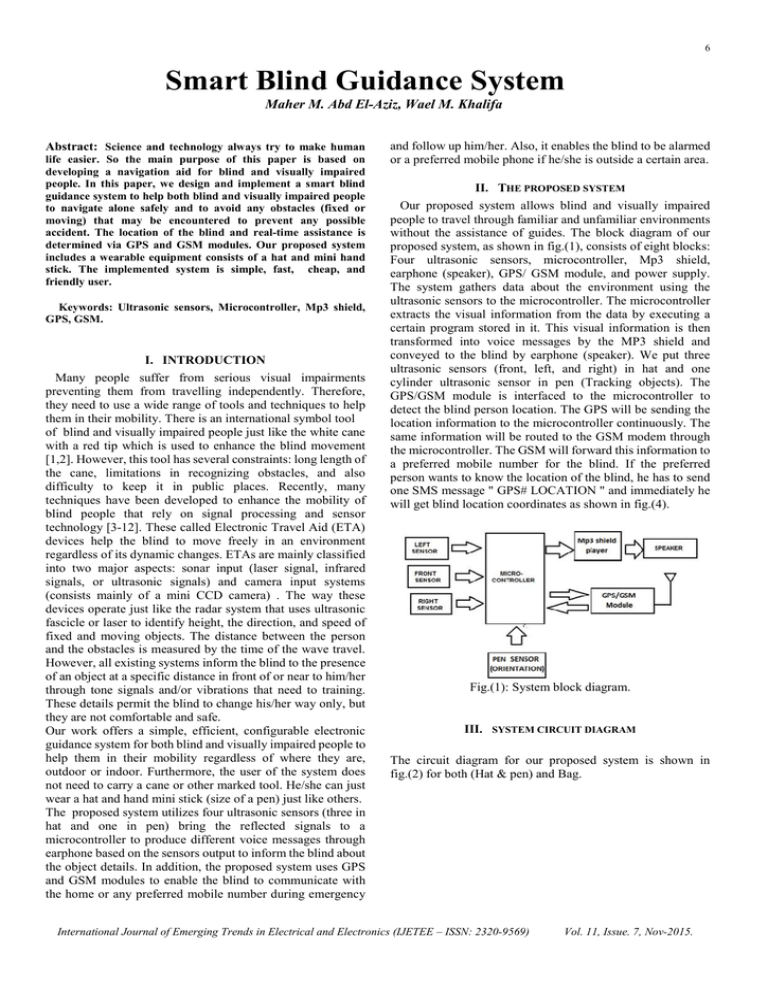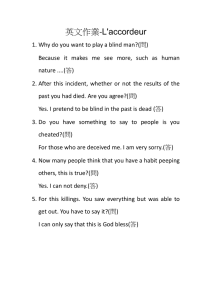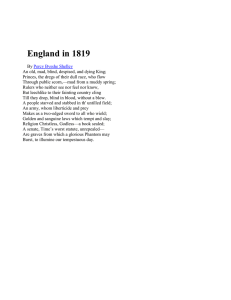Smart Blind Guidance System
advertisement

6 Smart Blind Guidance System Maher M. Abd El-Aziz, Wael M. Khalifa Abstract: Science and technology always try to make human life easier. So the main purpose of this paper is based on developing a navigation aid for blind and visually impaired people. In this paper, we design and implement a smart blind guidance system to help both blind and visually impaired people to navigate alone safely and to avoid any obstacles (fixed or moving) that may be encountered to prevent any possible accident. The location of the blind and real-time assistance is determined via GPS and GSM modules. Our proposed system includes a wearable equipment consists of a hat and mini hand stick. The implemented system is simple, fast, cheap, and friendly user. Keywords: Ultrasonic sensors, Microcontroller, Mp3 shield, GPS, GSM. I. INTRODUCTION Many people suffer from serious visual impairments preventing them from travelling independently. Therefore, they need to use a wide range of tools and techniques to help them in their mobility. There is an international symbol tool of blind and visually impaired people just like the white cane with a red tip which is used to enhance the blind movement [1,2]. However, this tool has several constraints: long length of the cane, limitations in recognizing obstacles, and also difficulty to keep it in public places. Recently, many techniques have been developed to enhance the mobility of blind people that rely on signal processing and sensor technology [3-12]. These called Electronic Travel Aid (ETA) devices help the blind to move freely in an environment regardless of its dynamic changes. ETAs are mainly classified into two major aspects: sonar input (laser signal, infrared signals, or ultrasonic signals) and camera input systems (consists mainly of a mini CCD camera) . The way these devices operate just like the radar system that uses ultrasonic fascicle or laser to identify height, the direction, and speed of fixed and moving objects. The distance between the person and the obstacles is measured by the time of the wave travel. However, all existing systems inform the blind to the presence of an object at a specific distance in front of or near to him/her through tone signals and/or vibrations that need to training. These details permit the blind to change his/her way only, but they are not comfortable and safe. Our work offers a simple, efficient, configurable electronic guidance system for both blind and visually impaired people to help them in their mobility regardless of where they are, outdoor or indoor. Furthermore, the user of the system does not need to carry a cane or other marked tool. He/she can just wear a hat and hand mini stick (size of a pen) just like others. The proposed system utilizes four ultrasonic sensors (three in hat and one in pen) bring the reflected signals to a microcontroller to produce different voice messages through earphone based on the sensors output to inform the blind about the object details. In addition, the proposed system uses GPS and GSM modules to enable the blind to communicate with the home or any preferred mobile number during emergency and follow up him/her. Also, it enables the blind to be alarmed or a preferred mobile phone if he/she is outside a certain area. II. THE PROPOSED SYSTEM Our proposed system allows blind and visually impaired people to travel through familiar and unfamiliar environments without the assistance of guides. The block diagram of our proposed system, as shown in fig.(1), consists of eight blocks: Four ultrasonic sensors, microcontroller, Mp3 shield, earphone (speaker), GPS/ GSM module, and power supply. The system gathers data about the environment using the ultrasonic sensors to the microcontroller. The microcontroller extracts the visual information from the data by executing a certain program stored in it. This visual information is then transformed into voice messages by the MP3 shield and conveyed to the blind by earphone (speaker). We put three ultrasonic sensors (front, left, and right) in hat and one cylinder ultrasonic sensor in pen (Tracking objects). The GPS/GSM module is interfaced to the microcontroller to detect the blind person location. The GPS will be sending the location information to the microcontroller continuously. The same information will be routed to the GSM modem through the microcontroller. The GSM will forward this information to a preferred mobile number for the blind. If the preferred person wants to know the location of the blind, he has to send one SMS message " GPS# LOCATION " and immediately he will get blind location coordinates as shown in fig.(4). Fig.(1): System block diagram. III. SYSTEM CIRCUIT DIAGRAM The circuit diagram for our proposed system is shown in fig.(2) for both (Hat & pen) and Bag. International Journal of Emerging Trends in Electrical and Electronics (IJETEE – ISSN: 2320-9569) Vol. 11, Issue. 7, Nov-2015. 7 (a): Hat and Pen circuit diagram (b): Bag circuit diagram. Fig.(2): Circuit diagram for the proposed system. IV. SYSTEM FLOW CHART Fig.(4): Flow chart for Hat sensors. V. SYSTEM COMPONENTS Four ultrasonic sensors (HC-SR04). MP3 Shield. Arduino –uno. Battery 9V. GPS/GSM module (SIM908). Arduino-ADK. Rechargeable battery. Fig.(3): Flow chart for Pen sensor. International Journal of Emerging Trends in Electrical and Electronics (IJETEE – ISSN: 2320-9569) Vol. 11, Issue. 7, Nov-2015. 8 VI. SYSTEM PROTOTYPE The prototype of our proposed is shown in fig.(5) for Hat, Pen, and Bag. Fig (6): GPS/GSM module operation. Table (1): Saved messages in MP3. Message Description (a): Hat and Pen prototype (b): Bag prototype Fig.(5): Proposed system prototype (Hat, Pen, and Bag). VII. RESULTS AND DISCUSSION The proposed system is designed and configured for practical use. The system is able to handle twelve states that may face the blind people. The system will respond to each state according to a specific program which is coded and installed in the microcontroller. Table (1) shows the twelve messages that will be conveyed to the blind by earphone according to the twelve states. Fig.(6) shows a test for determining the blind location using the GPS/GSM module. A comparison between our proposed system and the currently used systems is shown in table (2). M1 Left object M2 Right object M3 Front object M4 Near object M5 Normal object M6 Far object M7 Away object M8 Fixed object M9 Toward object M10 Slow object M11 Fast object M12 Please stop and use Pen Our proposed system has the following three categories: a. Complete system with free navigation system (using two microcontrollers). b. Complete system with wired navigation system (using one microcontroller). c. System without navigation system (hat & pen only). International Journal of Emerging Trends in Electrical and Electronics (IJETEE – ISSN: 2320-9569) Vol. 11, Issue. 7, Nov-2015. 9 Table (2): Comparison between currently used systems and our proposed one. System Structure Components O/P Response Features "Smart Walking Stickan electronic approach to assist visually disabled persons"[9] "Voice Based Guidance and Location Indication Using GSM, GPS"[10] Stick 2 US Sensors Vibrating motor Microcontroller 2 Electrods Vibrations -Not Affect by sun. -Needs for training. -Not comfortable. Stick US Sensors Vibrating motor Microcontroller GSM/GPS module Tones Vibrations Blind location -Not Affect by sun. -Needs for training. -Not comfortable. "Blind Audio Guidance System"[11] Stick 4 IR Sensors US Sensor Microcontroller APR 3 IR Sensors Vibrating motor Microcontroller Audio instructions -Affect by sun. -Needs for training. Tones Vibrations -Affect by sun. -Needs for training. -Not comfortable. 4 US Sensors Microcontroller MP3 shield GSM/GPS module Voice messages Blind location -Not Affect by sun. -No needs for training. -Comfortable. "A Smart Infrared Microcontroller -Based Blind Guidance System"[12] Proposed Hat & Pen Hat & Pen VIII. CONCLUSION This paper has described a system to transform visual information for the obstacle details acquired by the ultrasonic sensors to voice information through earphone. A simple, cheap, configurable, easy to handle electronic guidance system is proposed to provide constructive assistant and support for blind and visually impaired people. The main functions of this system are clear path indication and environment recognition. The US sensors have been fully utilized in order to advance the mobility of blind and visual impaired people in safe and independent way. The system is designed, implemented, and tested. The results indicate that the system is efficient in specifying the details of the objects that may encounter the blind. The proposed system is a real-time system that monitors position of the blind and provides dual feedback making his/her navigation more safe and secure. [5] G. Sainarayanan, R. Nagarajan, and S. Yaacob, “Fuzzy image processing scheme for autonomous navigation of human blind,” Applied Soft Computing Journal, vol. 7, no.1, pp. 257–264, 2007. [6] Z.-G. Fang, J. Xu, F.-l. Bao, and L.-H. Zhang, “AudioMan: design and implementation of environmental information data mapping,” Chinese Journal of Ergonomics, vol. 2, article 001, 2007. [7] M. Nie, J. Ren, Z. Li et al., “SoundView: an auditory guidance system based on environment understanding for the visually impaired people,” in Proceedings of the 31st Annual International Conference of the IEEE Engineering in Medicine and Biology Society: Engineering the Future of Biomedicine (EMBC ’09), pp.7240–7243, IEEE, September 2009. [8] D. Dakopoulos and N. G. Bourbakis, “Wearable obstacle Avoidance electronic travel aids for blind: a survey,” IEEE Transactions on Systems, Man and Cybernetics C, vol.40, no.1, pp. 25–35, 2010. [9] Mohammed Hazzaz, Rana Saha, and Sayemul Islam, " Smart Walking Stick – an Electronic approach to assist visually disabled persons ". International Journal of Scientific & Engineering Research, Vol.4, No.10, October 2013. [10] M. Naveen and K. Usha, " Voice Based Guidance and Location Indication System for the Blind Using GSM, GPS and Optical Device Indicator ". International Journal of Engineering Trends and Technology (IJETT), Vol. 4, No.7, July 2013. [11] Arjun Sharma, Rahul patidar, “ Blind audio guidance system”. International Journal of Emerging Technology and advanced Engineering (IJETAE), Vol. 3, No.3, January 2013. [12] Amjed S. Al-Fahoum and Ausaila A. Al-Fraihat, "A Smart Infrared Microcontroller-Based Blind Guidance System". Active and Passive Electronic Components, Hindawi publishing corporation, June 2013. IX. REFERENCES [1] D. Yuan and R. Manduchi, “Dynamic environment exploration using a Virtual White Cane,” in Proceedings of the IEEE Computer Society Conference on Computer Vision and Pattern Recognition (CVPR ’05), pp. 243–249, IEEE, San Diego, Calif, USA, June 2005. [2] A. A. Tahat, “A wireless ranging system for the blind long-cane utilizing a smart-phone,” in Proceedings of the 10th International Conference on Telecommunications (ConTEL ’09), pp. 111–117, IEEE, Zagreb, Croatia, June 2009. [3] K. Magatani, K. Sawa, and K. Yanashima, “Development of the navigation system for the visually impaired by using optical beacons,” in Proceedings of the 23rd Annual International Conference of the IEEE Engineering in Medicine and Biology Society, pp. 1488–1490, IEEE, October 2001. [4] N. G. Bourbakis and D. Kavraki, “An intelligent assistant for navigation of visually impaired people,” in Proceedings of the 2001 IEEE 2nd International Symposium on Bioinformatics and Bioengineering Conference, pp. 230–235, IEEE, 2001. Maher M. Abd El-Aziz is working as assist. Prof. in department CEC, Faculty of Engineering , Helwan University, Cairo, Egypt. Email: manmaher24@yahoo.com Wael M. Khalifa is an engineer graduated in July 2015 from ECE department, faculty of engineering, MSA university, Giza, Egypt. Email: wael.fabregas@yahoo.com International Journal of Emerging Trends in Electrical and Electronics (IJETEE – ISSN: 2320-9569) Vol. 11, Issue. 7, Nov-2015.




